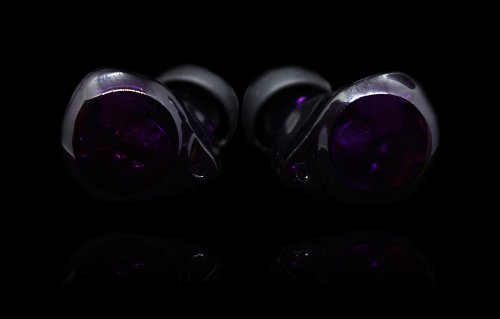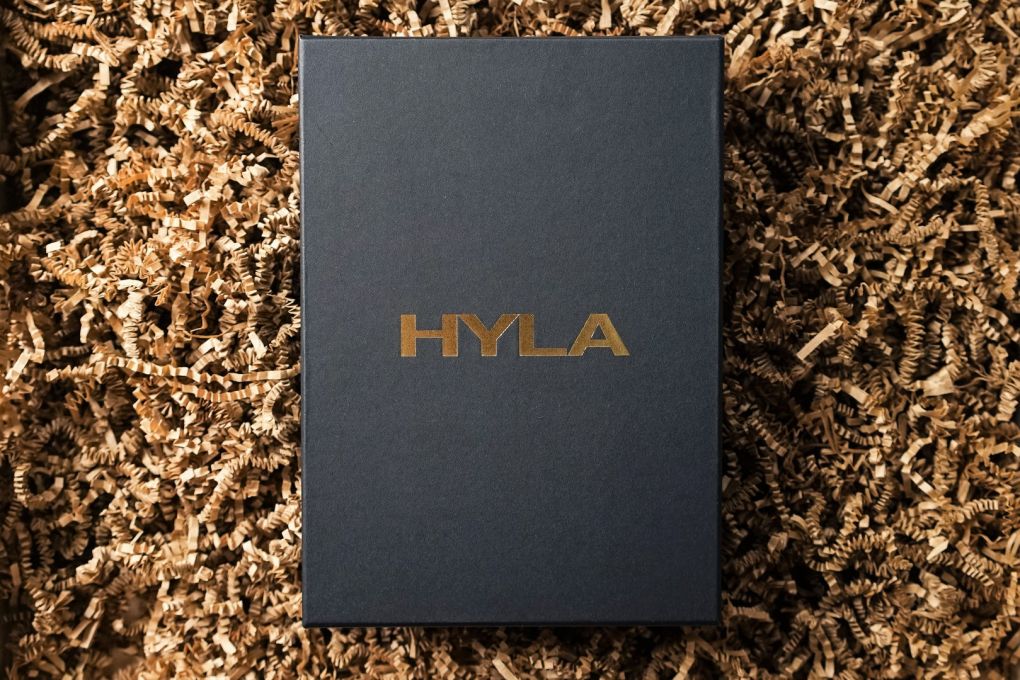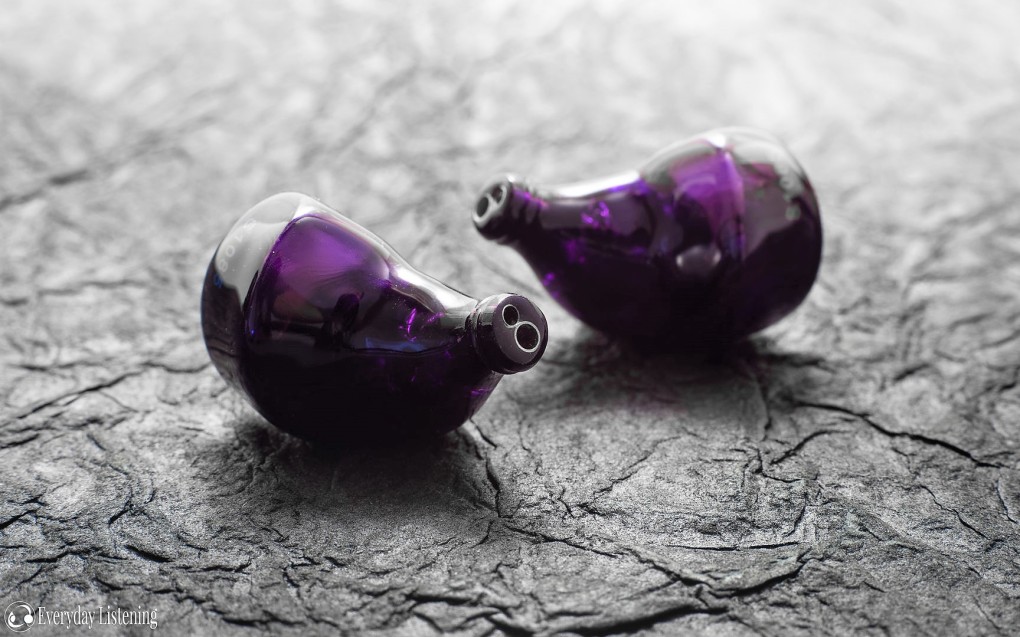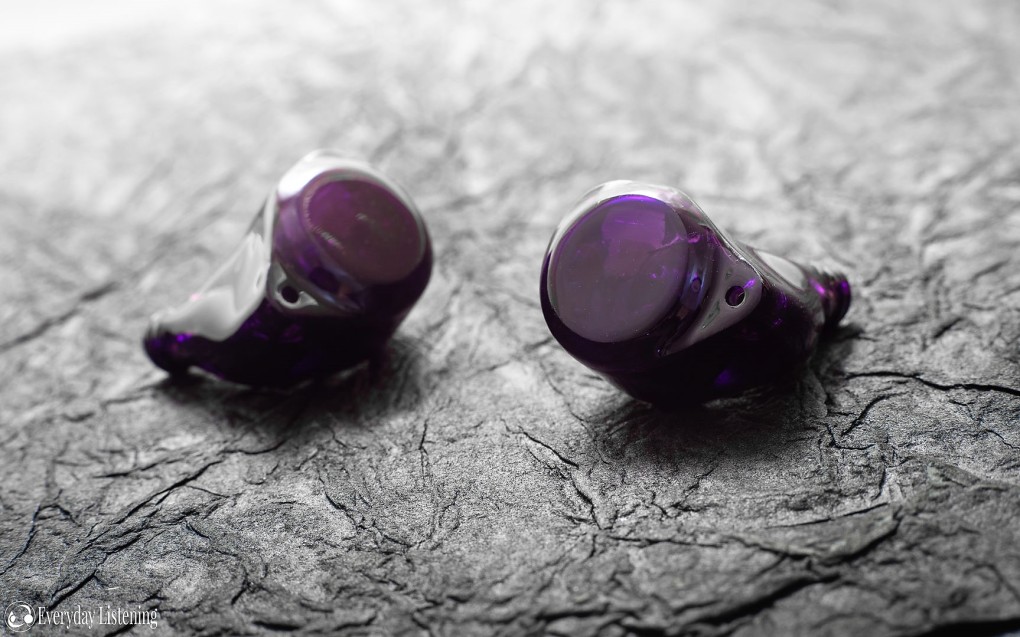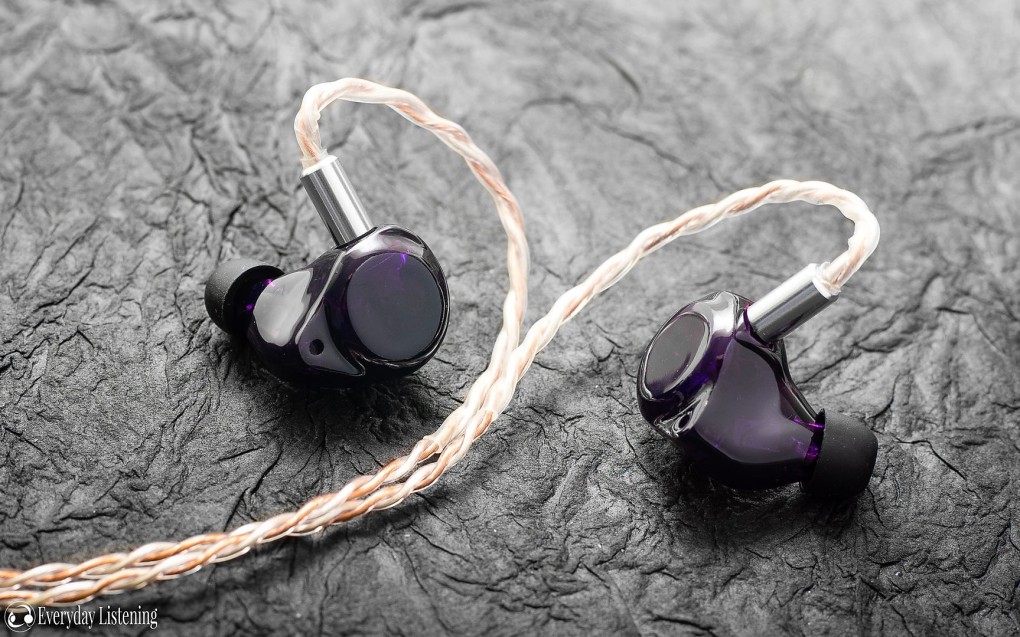Full Review: https://audiorambles.com/hyla-audio-ce-5/
Packaging and Accessories
Exterior wise, it’s a cardboard black box with a golden “HYLA” logo plastered upon the front. Upon opening the box, the CE-5 sits flush within two dimples, cushioned by a thin sheet of cloth which covers the entirety of the interior. Simple yet effective packaging, very pretty.
Accessories provided include:
– A small Van Nuys Carrying Case (not pictured here, sent for warranty)
– Foam tips
– A few pairs of silicone tips
-Cleaning tool
The carrying case is really good, sturdy enough to be useable yet small enough to be portable. The other accessories are kinda “eh”.
Build Quality, Fit, Comfort and Isolation

Aesthetics (8/10): The dark purple shells are quite endearing, although as a whole CE-5 is a little monotonous given its lack of significant design or pattern on its shells.
Build Quality (9/10): The CE-5 feels strong and sturdy to the touch, being made from medical grade German imported resin. The included braided black stock cable is a little thin for my personal tastes, but has well reinforced joints courtesy of the hard rubber material found on the Y-split and jack. Cables are also detachable in my personally preferred 2-pin connections.
Fit and Comfort (8/10): The shells of the CE-5 are quite large and sit outside of my ears a fair bit. Ironically, while the Jerry Harvey Roxannes are bigger than the CE-5 by a fair margin, I found the former a more comfortable experience. While you wouldn’t forget they’re in your ears, they’re still comfortable and don’t cause any discomfort for long-term listening.
Isolation (8.5/10): The CE-5 provides excellent isolation even though they’re vented, and with the right tips, blocks out a significant amount of sound.
Sound

Bass (9.5/10): The bass on the CE-5 is phenomenal, and genuinely one of the best, if not the best set of IEMs I have encountered in that regard.
The name of the game for the CE-5 is summed up by the word “control”. It never ever sounds loose or bloated, even while possessing such amazing slam and impact. The decay of the bass is naturally DD, lingering on for the perfect amount of time.
Subbass on the CE-5 is second to none, extending to the depths of hell, complemented by thunderous rumble and detail. There’s nothing quite like it, with even the JH Roxannes and the Z1R bowing to the CE-5 in terms of subbass response, unable to achieve the glorious rumble capable by the latter. “Royals” by Lorde was an absolute experience on the CE-5.
Midbass, in comparison, can even be termed as “recessed”. When viewed in isolation, however, it is merely just average in quantity. The quality, however, still shines through in ease, with excellent speed, detail and texture. It’s a cleaner, no-nonsense presentation than its subbass brethren, but might be a little thin for some. The basslines in Lauv’s “Paris in the Rain”, for example, don’t quite have the lush, addictive attack that the Roxannes do so well.
“Endgame bass in an IEM and only a 9.5?”, I hear you say, “how can this be allow?” The rating could have easily been a 10/10, but unfortunately the site belongs to me, and my personal preferences lean towards more midbass body. But for most, bass doesn’t get any better than this.
Mids (8/10): I’m quite ambivalent to the midrange on the CE-5. On one hand, there’s such clarity, resolution and detail that’s apparent on first listen. On the other hand, the tonal balance on the midrange of the CE-5 is relatively poor.
Female vocals are far and away the star of the show here, sounding exceedingly sweet and airy. They stand out with a commanding presence, as you hear every breath, every detail in tracks as vocalists like Adele belt their lungs out in tracks like “When we were young”, as every note is delivered with surgical precision.
However, as fantastic as the upper mids are, the lower mids are recessed and scooped in similar magnitude. While still exhibiting great resolution, male vocalists like Frank Sinatra or Andrea Bocelli have their wings clipped, lacking the body, weight and velvety texture traditionally associated with these singers. The lower midrange scoop greatly thins the midrange, and the tonal imbalance can be jarring at times, with both male and female vocals tending to sound nasal.
In many ways, they remind me of the Sony IER-Z1R, though the Z1R’s lower mids are less recessed than the CE-5’s, and are still the benchmark in resolution and clarity, being a step up from the CE-5. They do get close, though.

Highs (9/10): The Piezoelectric Ceramic Super Tweeter is no gimmick. Compared to traditional DD/BA setups, the Super Tweeter produces gobs of detail with excellent clarity, as every instrument sounds crisp and clean. However, the overall timbre exhibits something I personally think of as “EST Timbre” termed after Electrostatic Drivers, where the treble sounds so exceedingly clear it can feel slightly artificial. Not a significant issue, though.
In the lower treble, hi-hats and cymbals on “Hotel California” by the Eagles crash with clarity and authority, and the opening trumpet riff on Michael Buble’s “LOVE” is amazingly detailed, though perhaps sounding slightly thin at times. Best part is, the CE-5 while bright and detailed, is wonderfully tuned and has no detectable sibilance and harsh peaks.
Extension in the upper treble is effortless and quite smooth, retaining similar clarity and emphasis.
Soundstage, Imaging, Seperation and Timbre (8/10): The width of the CE-5 is just above average, though depth and height are both good. Imaging is excellent, as instruments are easily placed and identified across the soundscape. Separation is similarly fantastic, blowing complicated tracks like “Little Talks” out of the water. Timbre is where the CE-5 loses most of its points. While not preposterous, as previously mentioned instruments and vocals can sound a little thin/nasally, and its present more often than not.
Conclusions
The Hyla CE-5 easily gets a rec from me, especially given their asking price of merely USD $915, an absolute bargain for what its capable of. Tremendous bass response, resolution and technicalities at the expense of natural tone and timbre, but that’s a trade-off many are willing to take. The issue here would obviously be the fact that there’s only 200 out there in the wild, so you’d have to likely buy them second hand. Fantastic job, Hyla Audio.
Packaging and Accessories
Exterior wise, it’s a cardboard black box with a golden “HYLA” logo plastered upon the front. Upon opening the box, the CE-5 sits flush within two dimples, cushioned by a thin sheet of cloth which covers the entirety of the interior. Simple yet effective packaging, very pretty.
Accessories provided include:
– A small Van Nuys Carrying Case (not pictured here, sent for warranty)
– Foam tips
– A few pairs of silicone tips
-Cleaning tool
The carrying case is really good, sturdy enough to be useable yet small enough to be portable. The other accessories are kinda “eh”.
Build Quality, Fit, Comfort and Isolation

Aesthetics (8/10): The dark purple shells are quite endearing, although as a whole CE-5 is a little monotonous given its lack of significant design or pattern on its shells.
Build Quality (9/10): The CE-5 feels strong and sturdy to the touch, being made from medical grade German imported resin. The included braided black stock cable is a little thin for my personal tastes, but has well reinforced joints courtesy of the hard rubber material found on the Y-split and jack. Cables are also detachable in my personally preferred 2-pin connections.
Fit and Comfort (8/10): The shells of the CE-5 are quite large and sit outside of my ears a fair bit. Ironically, while the Jerry Harvey Roxannes are bigger than the CE-5 by a fair margin, I found the former a more comfortable experience. While you wouldn’t forget they’re in your ears, they’re still comfortable and don’t cause any discomfort for long-term listening.
Isolation (8.5/10): The CE-5 provides excellent isolation even though they’re vented, and with the right tips, blocks out a significant amount of sound.
Sound

Bass (9.5/10): The bass on the CE-5 is phenomenal, and genuinely one of the best, if not the best set of IEMs I have encountered in that regard.
The name of the game for the CE-5 is summed up by the word “control”. It never ever sounds loose or bloated, even while possessing such amazing slam and impact. The decay of the bass is naturally DD, lingering on for the perfect amount of time.
Subbass on the CE-5 is second to none, extending to the depths of hell, complemented by thunderous rumble and detail. There’s nothing quite like it, with even the JH Roxannes and the Z1R bowing to the CE-5 in terms of subbass response, unable to achieve the glorious rumble capable by the latter. “Royals” by Lorde was an absolute experience on the CE-5.
Midbass, in comparison, can even be termed as “recessed”. When viewed in isolation, however, it is merely just average in quantity. The quality, however, still shines through in ease, with excellent speed, detail and texture. It’s a cleaner, no-nonsense presentation than its subbass brethren, but might be a little thin for some. The basslines in Lauv’s “Paris in the Rain”, for example, don’t quite have the lush, addictive attack that the Roxannes do so well.
“Endgame bass in an IEM and only a 9.5?”, I hear you say, “how can this be allow?” The rating could have easily been a 10/10, but unfortunately the site belongs to me, and my personal preferences lean towards more midbass body. But for most, bass doesn’t get any better than this.
Mids (8/10): I’m quite ambivalent to the midrange on the CE-5. On one hand, there’s such clarity, resolution and detail that’s apparent on first listen. On the other hand, the tonal balance on the midrange of the CE-5 is relatively poor.
Female vocals are far and away the star of the show here, sounding exceedingly sweet and airy. They stand out with a commanding presence, as you hear every breath, every detail in tracks as vocalists like Adele belt their lungs out in tracks like “When we were young”, as every note is delivered with surgical precision.
However, as fantastic as the upper mids are, the lower mids are recessed and scooped in similar magnitude. While still exhibiting great resolution, male vocalists like Frank Sinatra or Andrea Bocelli have their wings clipped, lacking the body, weight and velvety texture traditionally associated with these singers. The lower midrange scoop greatly thins the midrange, and the tonal imbalance can be jarring at times, with both male and female vocals tending to sound nasal.
In many ways, they remind me of the Sony IER-Z1R, though the Z1R’s lower mids are less recessed than the CE-5’s, and are still the benchmark in resolution and clarity, being a step up from the CE-5. They do get close, though.

Highs (9/10): The Piezoelectric Ceramic Super Tweeter is no gimmick. Compared to traditional DD/BA setups, the Super Tweeter produces gobs of detail with excellent clarity, as every instrument sounds crisp and clean. However, the overall timbre exhibits something I personally think of as “EST Timbre” termed after Electrostatic Drivers, where the treble sounds so exceedingly clear it can feel slightly artificial. Not a significant issue, though.
In the lower treble, hi-hats and cymbals on “Hotel California” by the Eagles crash with clarity and authority, and the opening trumpet riff on Michael Buble’s “LOVE” is amazingly detailed, though perhaps sounding slightly thin at times. Best part is, the CE-5 while bright and detailed, is wonderfully tuned and has no detectable sibilance and harsh peaks.
Extension in the upper treble is effortless and quite smooth, retaining similar clarity and emphasis.
Soundstage, Imaging, Seperation and Timbre (8/10): The width of the CE-5 is just above average, though depth and height are both good. Imaging is excellent, as instruments are easily placed and identified across the soundscape. Separation is similarly fantastic, blowing complicated tracks like “Little Talks” out of the water. Timbre is where the CE-5 loses most of its points. While not preposterous, as previously mentioned instruments and vocals can sound a little thin/nasally, and its present more often than not.
Conclusions
The Hyla CE-5 easily gets a rec from me, especially given their asking price of merely USD $915, an absolute bargain for what its capable of. Tremendous bass response, resolution and technicalities at the expense of natural tone and timbre, but that’s a trade-off many are willing to take. The issue here would obviously be the fact that there’s only 200 out there in the wild, so you’d have to likely buy them second hand. Fantastic job, Hyla Audio.




